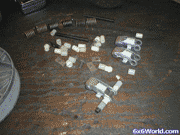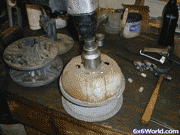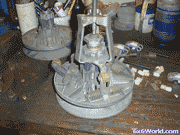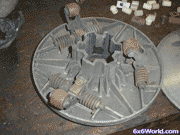Salsbury was a very popular brand of clutch system for many of the amphibious ATVs from the 1960s to around 1980 when they closed up shop. Attex, Hustler, Scrambler and Max used them on at least some of their models, and I'm sure more of the lesser known machines used Salsbury as well.
Attex used model 910 for the ST400, Chief, Thunderchief and Superchief and the 780 for most of it's single cylinder two-strokes. I'll try and be clear on how to do a simple rebuild of the 910. The 780 is very similar in design and goes pretty much the same way.
Safety First!
I can't stress enough the importance of safety glasses when you're working on the clutch, especially the springs. Other than that, the only caution will be to keep your fingers out of the way whey you're moving the clutch faces or springs.
Let's Begin!
First thing to do is find the parts to do the rebuild and that's harder than the rebuild itself. Lately there have been some NOS kits on the internet, mostly on ebay. If you find a kit, you'll still need to find the nylon spline liners. I've never found a kit that includes them.

It's better to push the outer clutch face in towards the inner far enough so that it "locks" over center before you take it apart. This way the springs aren't loaded against the outer cover (ramp plate). Keep your fingers from between the pulley faces! (or it'll hurt) If you don't have access to an impact wrench to pull the retainer nut, it's easier to flatten the lock plate and loosen the nut before the clutch is removed from the engine. If the clutch is off the engine, I always use an impact wrench when possible- it makes it lots easier.

When the cover's off you see the guts of the clutch. With this particular unit it was easy to push the faces together and once inside it was easy to see why: only one spring was intact. Usually it's easier to remove the hex bolts and release the spring tension before the spider is removed, but in this case it wasn't necessary.
Use a puller on the spider and pull it straight off the end of the hub.

Once the spider is off, the moveable face can be removed and disassembled. Release the springs from the roller arms with a pair of pliers or a screwdriver, then flatten the locks around the hex bolts and remove them.

Remove the rollers, bushings, and arms from the moveable face. The only thing left to remove are the nylon spline liners from the fixed face of the clutch. They should pull off easily.
Use brake cleaner or similar degreaser to clean up all the parts you plan to reuse and brush them off with a soft wire brush or wire wheel. Check all the moving parts for wear, especially the spline on the fixed face. It should have no grooves, or at least minimal grooves in the spline surface.
I've put clutches together with minor wear and as long as the nylon spline liners are replaced, the clutch works like new. The inner splines on the movable face of the clutch don't seem to wear out as easily, but they should be checked as well. The spider arms should be flat on the surface that the rollers contact with and have no depressions. If there are uneven spots on this piece, the clutch will "jump" under certain conditions.


 Sections
Sections Recent Forum Posts
Recent Forum Posts


 Currently Active Users
Currently Active Users
 Latest Poll
Latest Poll
Sorry no one has replied yet. I’ve got the same...
Sorry no one has replied yet. I’ve got the same engine. It could be at the wiring harness that was disconnected by the engine. I’ve had trouble with where the wires go into the back of the connector...
tbone9 11-20-2024, 12:22 PM